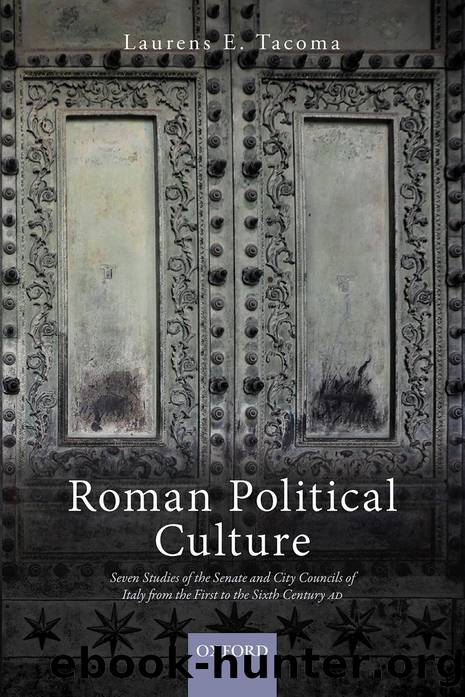Roman Political Culture by Laurens E. Tacoma;

Author:Laurens E. Tacoma; [Tacoma, Laurens E.]
Language: eng
Format: epub
ISBN: 9780192591180
Publisher: OUP Premium
Published: 2020-02-24T00:00:00+00:00
1. Constantineâs Rescript to Hispellum
Somewhere late in the reign of Emperor Constantine (ad 306â337) the community of Hispellum (mod. Spello in Umbria) received a rescript from the emperor. It was an answer to a petition Hispellum had sent. The city wanted to be renamed after the imperial family, it wanted to hold its own festival with theatrical shows and gladiatorial games, rather than having to send its priest to the festival at the Tuscan city of Volsinii, and it wanted to dedicate a shrine to the Constantinian dynasty. Constantine responded positively to these requests, and it was this elaborately formulated reply that the community decided to etch in stone. It erected a large stela with the inscription at the sanctuary where the festival was to be held, on the slope of the hill on which the city of Hispellum was located.
The inscription was retrieved from the site of the former sanctuary in 1733.1 Although the stone is broken into three parts, the text is preserved completely. The text calls itself a copy, an exemplum, of the imperial rescript.2 In keeping with Constantinian rhetoric, the style is verbose, and in consequence, the text is rather long.3 However, although the stone is significant in size, the layout and lettering are rather careless. The text turns out to be a rather sloppy copy of the original imperial rescript, full of spelling errors. The mistakes can to some extent be blamed on the carelessness of the copyist, but can also be attributed to changes in late-antique pronunciation.4
Although apart from the heading the text shows no divisions in its layout, the content divides neatly into a number of sections. After stating that it was a copy of the imperial rescript, the text started with the names of the emperor and his sons.
Imperator Caesar Flavius Constantine Maximus, conqueror of the Germans, Sarmatians, and Goths, victor, celebrator of triumphs, augustus, with Flavius Constantine and Flavius Julius Constantius and Flavius Constans.5
This seemingly innocuous opening has given rise to intense debate, as the clause inhibits precise dating. It is of some irony that Constantine himself had stated previously that laws without an exact date were invalid.6 Originally the rescript must have had a dating clause, but it was not included in the copy.7 The problem is that the titles for the Emperor Constantine are given in full, but that the heading also mentions three sons of Constantine (Constantinus, Constantius, and Constans), without giving further titles or any indication of their status. The use of victor rather than invictus in Constantineâs titles places the text certainly after ad 324.8 As the son from Constantineâs first marriage, Crispus, is not mentioned, the text almost certainly dates from after his execution in ad 326. The year of Constantineâs death, ad 337, is the terminus ante quem, with the proviso that during the months following his demise rescripts were still issued in Constantineâs name.9 The period between the elevation of Dalmatius, Constantineâs nephew, to the caesarship in ad 335 up until his murder
Download
This site does not store any files on its server. We only index and link to content provided by other sites. Please contact the content providers to delete copyright contents if any and email us, we'll remove relevant links or contents immediately.
| Africa | Americas |
| Arctic & Antarctica | Asia |
| Australia & Oceania | Europe |
| Middle East | Russia |
| United States | World |
| Ancient Civilizations | Military |
| Historical Study & Educational Resources |
Machine Learning at Scale with H2O by Gregory Keys | David Whiting(3658)
Never by Ken Follett(3547)
Fairy Tale by Stephen King(2965)
The Man Who Died Twice by Richard Osman(2820)
Oathbringer (The Stormlight Archive, Book 3) by Brandon Sanderson(2657)
Will by Will Smith(2591)
Rationality by Steven Pinker(2158)
The Dark Hours by Michael Connelly(2090)
The Dawn of Everything: A New History of Humanity by David Graeber & David Wengrow(2021)
Friends, Lovers, and the Big Terrible Thing by Matthew Perry(2016)
Can't Hurt Me: Master Your Mind and Defy the Odds - Clean Edition by David Goggins(2010)
Principles for Dealing With the Changing World Order: Why Nations Succeed and Fail by Ray Dalio(1903)
HBR's 10 Must Reads 2022 by Harvard Business Review(1702)
A Short History of War by Jeremy Black(1677)
Go Tell the Bees That I Am Gone by Diana Gabaldon(1601)
515945210 by Unknown(1524)
443319537 by Unknown(1400)
Kingdom of Ash by Maas Sarah J(1395)
A Game of Thrones (The Illustrated Edition) by George R. R. Martin(1377)
